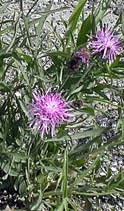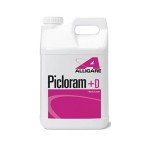
Spotted knapweed is an aggressive short-lived perennial brought to North America from Eurasia in the 1890s in contaminated crop seed. Since then it has spread to almost every state in the US where it invades recently disturbed sites with light well drained soil and sun to part shade. It can be found in perennial beds and shrub borders as well as on roadsides, along railroad tracks, and at the edges of agricultural fields. This weed is especially troublesome because it produces a chemical in the soil that inhibits the growth of nearby plants.
Description: The first year knapweed forms a basal rosette of deeply lobed leaves 2” wide by 8” long. In following years an erect, stem grows 2 to 4 feet tall, producing branches on its upper half. The stem bears pale green alternate leaves that are less lobed that the leaves of the basal rosette and diminished in size towards the tip. During the summer pink to light purple flowers are produced in dense heads ½” across and subtended by bracts with black spots, giving the plant its common name. The seeds are brown, less than 1/8” wide and bear a short tuft of bristles. A single plant can produce over 1,000 seeds that may remain in the soil for five years or more. A deep, thick taproot forms the root system.
Control: Hand pulling the rosettes is effective if care is taken to remove the crown so the taproot will not sprout. Heavy infestations are best treated with herbicides such as picloram which give control for more than a single year. 2,4-D and glyphosate are possible choices but are less effective over time and will require several applications.

To buy Picloram+D from Amazon.com click here.